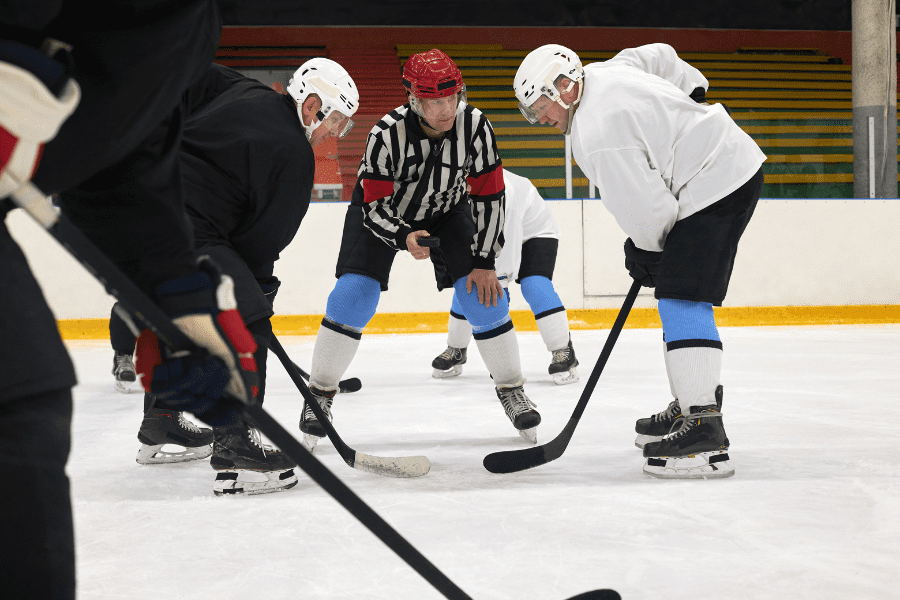How Hockey Lines Work
Ever wonder how Hockey lines work? From the rapid-fire offense of the power play to the stalwart defense of the penalty kill, this article offers an in-depth look at the orchestration behind the scenes. Learn how offensive lines work to outmaneuver opponents, defensive lines stand firm to protect their zone, and special teams shift the game’s momentum in moments of power play and penalty kill. Ideal for enthusiasts eager to deepen their understanding and players aiming to sharpen their play, this article lays bare the intricacies of hockey lines, revealing how they shape the flow and outcome of every match!

I will break down the fundamentals of hockey lines, from the basics to advanced strategies. Whether you’re a player or parent looking to deepen your knowledge or master the concepts of hockey lines enhances your overall understanding and enjoyment of the Ice Hockey.
Key Takeaways:
- Understanding hockey line combinations.
- Hockey lines consist of Offense: three forwards and Defense: two defensemen.
- Each line has specific roles and responsibilities, both in offense and defense.
- Proper player positioning and chemistry within the lines are essential for success.
- Hockey line management involves strategic decision-making and adaptability.
Introduction to Hockey Line Basics
Understanding the basics of how these lines are structured and operate is essential for both players and fans.
In this section, we will explore the different aspects of hockey lines, including forward lines, defense pairs, and line changes, providing a comprehensive introduction to the fundamentals of hockey line management.
The Role of Forward Lines in Hockey
Forward lines are responsible for the offensive aspect of the game, aiming to score goals and create scoring opportunities.
Each forward line consists of a center, a left winger, and a right winger.

In the realm of offense, centers take charge of leading the attack, facilitating puck distribution, and often doubling down on defense.
Wingers, both left and right, flank the center, focusing on creating scoring chances and supporting the center in puck retrieval.
These players work cohesively to maintain possession, execute passing plays, and penetrate the opposing team’s defense.
The center typically leads the line, directing the flow of the game and facilitating communication among the forwards.
The left and right wingers provide support and utilize their agility and speed to create offensive threats.
Defense Pairs and Their Significance

Defense pairs in hockey consist of two defensemen who work together to provide a solid defensive presence and support the goaltender.
These duos aim to maintain defensive positioning, block shots, and neutralize the opponent’s offensive efforts. They need clean defense skills to rid the puck from the opponent.
Defensemen must have excellent communication skills and coordination to ensure seamless transitions between offensive and defensive plays. They need to have a keen eye and hockey IQ to predict the likelihood of where that puck may end up and position themselves accordingly.
They work alongside the forward lines to maintain defensive coverage and initiate offensive movements.
Goalies, the last line of defense, command the crease, making critical saves and guiding their teammates with their view of the entire ice.
Deploying Defense Pairs with Chemistry
Defense pairs play a crucial role in maintaining a strong defensive presence on the ice. Coaches aim to deploy defense pairs with chemistry and complementary playing styles. This ensures effective communication, defensive coverage, and smooth transitions from defense to offense.
When forming defense pairs, coaches often pair a more offensive-minded defenseman with a defensive-minded counterpart. This combination allows for a balance between offensive contributions and defensive responsibilities. Additionally, coaches consider factors such as players’ compatibility, communication skills, and ability to support each other in high-pressure situations.
How Line Changes Influence the Game
Line changes are an essential aspect of hockey, allowing teams to maintain fresh legs and blood and an effective lineup on the ice.
Coaches strategically time line changes to optimize player performance and match line combinations against the opposing team’s weaknesses, and the least disruption during a play.
Effective line changes require quick transitions, proper communication, and coordinated teamwork, ensuring a seamless flow of players onto the ice without compromising defensive coverage.
This requires practice. From when kids are big enough to jump the board in front of the bench or extra hands to open the door to allow for quick line changes.
Ice Hockey Player Positioning and Line Combinations

Player positioning in ice hockey is crucial for any team aiming for victory.
This involves assigning specific roles and responsibilities to players based on their positions, ensuring that every inch of the ice is effectively covered.
Through strategic positioning and effective line combinations, including the mixing of players to leverage their strengths.
Coaches orchestrate a game plan that encompasses a robust defense, a dynamic offense, and the flexibility to adapt to the game’s ebb and flow.
The Integration of Special Teams
Special teams play a significant role in the game of hockey.
Coaches strategically form power play and penalty kill units to gain an advantage in specific situations.
These units typically consist of a mix of forwards and defensemen who possess the necessary skills to excel in their respective roles.
When integrating special teams into a game plan, coaches evaluate players’ strengths, shooting abilities, and power play/penalty kill prowess.
They aim to form units that can outperform the opponent’s penalty kill or successfully defend against the opponent’s power play.
Effective special teams can be a game-changer and heavily impact a team’s success. Special teams like the power play unit for offensive surges and the penalty kill squad to defend against them.
Mastering Hockey Line Management
Hockey Line Matching: The Art of Adaptation
In the game of hockey, line matching is a crucial aspect of strategy.
By understanding the strengths and weaknesses of both their team and the opponent, coaches can make informed decisions about line combinations that will give their team an edge.
Line matching involves strategically assigning lines to go up against specific opponents on the ice, ensuring that the players’ skills and abilities are best utilized to counter the opposing team’s strengths.
This adaptability allows for a more dynamic and competitive game, allowing teams to exploit advantageous matchups and neutralize threats from the opposition.
Adjusting Hockey Lines for Energy and Efficiency
Keeping players energized throughout a hockey game is key for peak performance. This is achieved through smartly managing player shifts on the ice.
Coaches keep a close eye on the game’s pace and player energy, swapping in fresh legs at the right moments. This swapping, or modulating lines, means players get crucial rest periods, ensuring they can play at their best when on the ice.
By rotating players in and out in a strategic manner, every team member stays more alert and ready for action. This not only keeps the game’s intensity up but also enhances the team’s overall effectiveness by preserving player energy for crucial moments.
Mastering Special Teams: The Art of the Power Play and Penalty Kill

In the strategic world of hockey, special teams are a pivotal element of game play and line strategy. The ability to leverage a power play or effectively navigate a penalty kill can dramatically influence the game’s dynamics.
When a team gains a power play advantage or needs to mount a strong defense during a penalty, selecting the optimal lineup is key.
This involves deploying players with specialized skills suited for the intensified offensive push or the critical defensive stand, aiming for a strategic edge that can boost scoring chances by around 20% during power plays.
Coaches meticulously craft these lineups, pulling from their roster those adept in navigating the unique demands of power play and penalty kill situations.
Success in these moments can tip the scales, turning the tide of the match and securing a competitive advantage against rivals.
Conclusion
Understanding how hockey lines work is crucial for players, coaches, and fans alike.
By comprehending the roles and strategies behind these lines, we gain a deeper appreciation for the teamwork and coordination involved in ice hockey.
As an experienced ice hockey parent, I have witnessed firsthand how important it is for players to grasp the dynamics of hockey lines.
These lines not only organize players into specific roles, but they also provide a framework for executing plays, defending against opponents, and creating scoring opportunities.
From the forward lines that drive the offensive play to the defense pairs that provide crucial defensive coverage, every player contributes to the team’s overall strategy. Coaches strategically deploy line combinations and make adjustments based on the opponent’s lineup, creating favorable matchups and optimizing energy and efficiency.
FAQ
What is the role of forward lines in hockey?
Forward lines in hockey are responsible for offense, scoring goals, and creating opportunities. Typically composed of a center, a left winger, and a right winger, these players work together to maintain possession, execute plays, and create scoring chances.
What is the significance of defense pairs in hockey?
Defense pairs in hockey play a vital role in protecting the defensive zone and preventing the opposing team from scoring. Each pair consists of two defensemen who work together to cover the ice and defend against the opponent’s offense.
How do line changes influence the game?
Line changes in hockey allow teams to maintain fresh legs on the ice, ensuring players are not fatigued. Coaches strategically time line changes to maintain momentum, exploit matchups, and manage player energy levels during a game.
How can line combinations affect player positioning in ice hockey?
Line combinations in hockey determine players’ positions on the ice, which affects their responsibilities and areas of coverage. Coaches strategize line combinations to optimize player chemistry, offensive and defensive capabilities, and overall team performance.
How important is special teams in hockey line management?
Special teams, such as the power play and penalty kill, require specific line configurations to take advantage of or neutralize the opposing team’s situation. Coaches make strategic decisions on line combinations to maximize effectiveness during special teams situations.
What is hockey line matching and how does it impact the game?
Hockey line matching is the practice of strategically matching lines against an opponent’s lines to create favorable matchups. Coaches analyze the opponent’s lineup and adjust their line combinations to exploit weaknesses or nullify strengths, aiming to gain a competitive advantage.
How do coaches adjust lines for energy and efficiency in hockey?
Coaches modulate lines in hockey to optimize energy and efficiency by managing player fatigue and individual skill sets. By rotating lines strategically and assessing player performance, coaches ensure players can maintain a high level of play throughout the game.



